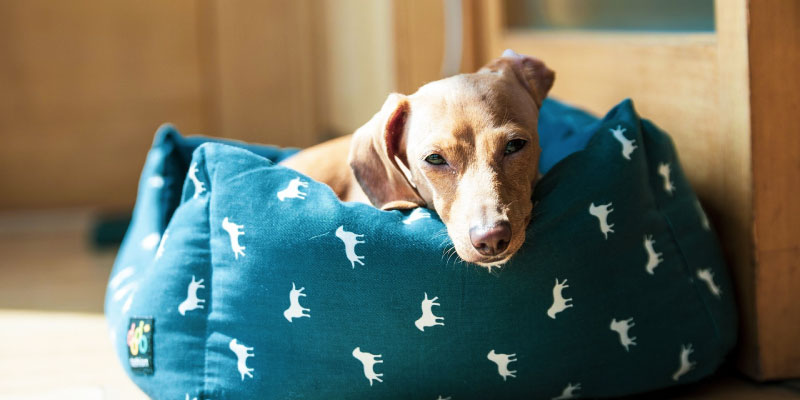If you are reading this, you've either decided to move from a dog crate to a bed, or are avoiding dog crate training your puppy or dog and want a safe comfortable dog bed for your fur baby.
This isn't going to be an article about whether your dog should sleep in a crate or a bed. Both are good solutions, some people keep their dogs in their crates for years, other use it only whilst they are puppies, some combine the two... what's right for some is not for other.

However, most dog owners will have at least one dog bed in their homes at some points – if your home is large enough, you may need multiple beds.
But it’s a big dog bed world out there, with lots of choice and styles available. You also don’t want to spend money on a dog bed that your puppy won’t use.
Here’s a guide to making sure you pick the perfect bed first.
How to select a dog bed
Before you buys a bed, first you got to ask your dog what he might want. Not fluent in ruffs and woofs? You don’t have to be, (s)he will tell you exactly what they need depending on their size, age, and way they sleep.
Watch your dog sleep
Much like Humans, dogs move, change and shift in their sleep. But much like their owners, you’ll start to see that they do have a favourite position.
Maybe they like to hide behind the curtain, maybe the take up the entire floor space and trip you up each and every time, maybe they cuddle up in a dark corner. Make a note: for every sleep preference there is a type of bed suitable for your dog.
Here is what to look out for:
- The Curler: with his or her nose to their butts, it’s like watching an infinity loop of doggy cuteness.
- The Spreader: this dog will look like it’s doing yoga in their sleep, with their toes stretch as far from each other as possible.
- The Hider: Under tables and chairs, behind curtains, snuggled in a blanket, this dog is hard to find.
- The Leaner: whether it’s by your feet or against your legs, this puppy is like your own personal heater. Bonus point for the dogs that like to use your legs as a headrest and pins you to your sofa.
- The Goldilocks: Not to hot, not too cold, this goldilocks dog will either love nothing more than to spread his legs onto your heated floor, or sit by the entrance of the door to catch the cool breeze.
If your puppy falls into a couple of categories, don’t worry. In this vast internet dog world, we promise that there is a solution.
How to measure your dog in his sleep
To determine the size of bed you might need, you’ll have to measure your dog whilst he is sleeping. You can take a guess, but we guarantee that different bed shops will have different ideas of what is a ‘large’, ‘medium’ or ‘small’ dog.
A good general good of thumb is measure your dog sleeping. Wait until they are in a comfortable position, and take a tape measure from their nose down to their tail bone. Then you should probably add about 8 to 12 inches to give you the length or diameter of the bed.
Ask yourself:
- Is my dog fully grown? If not, you may want to gamble on a bigger dog bed based on an average size of your breed if you don’t want to dish out the money on multiple beds as they grow.
- Can I add padding? If you don’t want to buy a puppy bed and then a bigger bed later, could you buy a bigger bed and then add blankets and padding to keep it cosy as they grow?
- What if I have a mix-breed? If you don’t know the breed of your dog for sure, it’s best to buy for the size they are now, or go for a mat or blanket until you know their final size.
Consider any special needs
You know how they sleep, you know their size, now you have to consider the X factors: personality, age and breed. Here some of the things to consider when picking the perfect dog bed for your pup.
- Personality: is your dog anxious, nervous or a destroyer? If the first two, you’ll want to consider anti-anxiety dog beds, if the third, you’ll want to find mesh or tough dogs beds that will resist that chewing temptation.
- Puppy Beds: If you are not crate training your puppy, you’ll need to accept that accidents happen.
Memory foam beds, for example, keep odours for a long time, so make sure you have a good waterproof dog cover. If you are buying a bed just for the puppy stage, consider going economical – not only will it only last them a short while, but you don’t know if they will eventually destroy or change how they sleep as they get older. - Orthopaedic Dog Beds: This may sound ridiculous to new dog owners, but trust us; when a member of your family is suffering from arthritis or just simply slowing down from general aches and pains, you are going to want to provide them with the comfort they deserve. These thick
memory foam beds shape themselves around your dog, giving them a comfortable night sleep. - Cooling Beds: It’s much easier to keep a dog warm than it is to keep them cool. Short of shaving their thick fur or long hair and giving them access to water, there isn’t much you can do, right? Wrong. You can get their cot beds which lift off the ground and gives them airflow beneath them or you can get cooling pads that will give them that nice ‘cold tile’ feeling on a hot summers day. Whether your dog required this kind of extras will mostly depend on the breed.
What Type of Bed Do Dogs Prefer?
Now that you know your dogs personal sleep preferences, you have to consider practicality – trying to find a ‘cave’ type dog for a 120 pounds Irish Wolfhound is going to be costly and difficult, and you may find that you could probably buy just a normal pillow for a Chihuahuas.
But you’ll probably find that as a breed, Wolfhounds would rather have the pillow and the Chihuahuas a cave. As a general rule, big dogs like to spread, little one like to curl up and ease their anxiety. It tough behind the smallest breed of the canine world.
There is no right or wrong answer and you may even have to get several tries to find the perfect bed. There’s a million out there with a million different designs, but we’ve broken up the general shapes and different types of dog beds that you will find on the internet.
Mats
Mats are basically nothing more than a blanket in disguise, set in a specific shapes. Usually you’ll find that they are made to fit perfectly in crates, to give it a little extra comfort, but can be generally used around the home.
Once you teach your dog to realise this is his space, they can be places on cold floors to take the chill off, on sofa to keep them clean, or in cars to give them a little extra comfort.
However, they are generally not a good long term solution as they only provide a small degree of comfort and protection from the hard floors.
- Good for spreaders and chewers
- Usually cheapest option
- Great for travelling and moving around the home
- Easy to clean as easy to fit in standard washing machines
- Good for almost all types of dogs.
- Provides only a small amount of protection
- Not a long term solution for comfort
Pillows or Loose-fill beds
These are filled sacks of material which creates a rectangular bed of various sizes – much like a pillow. However, buying these types of beds requires the most research as cheaper or bad quality types may not last as long as you may like. This is because the filler may bunch up or break down over time, making them less effective or with spots that have no padding.
The most common type of filling will be polyester fibbers, but you can find some with bean bag foam beads or even cotton batting. We would recommend you try and stay from shredded cedar.
Although many bed shops will try and sell you these types of bed as they are excellent bug repellents (attractive for to those living in warmer climes and the dog bed is outside), in truth the strong scent can trigger respiratory issues or allergies in dogs. It’s not common, but is this something you want to discover?
More importantly, check out the washing instructions of these pillow beds. Can you remove the covers and wash separately from the filling? If so, that bed will last you a lot longer than one you need to wash with the filling, making it more likely that it will clump.
Equally, as these are typically bought for larger breeds of dog, chances are, you won’t be able to fill a whole bed, filling and all, in a washing machine, needing to use a launderette or specialised facilities. In other words: expensive. So if you know nothing more about these kinds of beds, make you you can remove the cover for washing.
- Great for Large Dogs
- Great for Spreaders
- Comfortable padding dogs will love
- Easy to put away or move around
- Variety of materials available – including waterproof for dogs who may have little accidents, durable materials for notorious chewers.
- Good for Goldilocks of either kind: buy cool leather for those who like it cool, or warm fluffy material for those who like it hot.
- Filling can clump or come apart
- Those without a removable cover will not last as long or are impossible to wash
- Many of the covers may not survive strong chewers and scratchers
- The Shredded cedar fillings may cause allergic reactions in some dogs
- Worth investing more to ensure quality
Hammocks
These Hammocks type bed are particularly popular with kennels, dogs shelters, and in places where it gets hot; think Australia, Florida, or Spain.
The reasons should be fairly obvious: these are easy to clean and cool. In fact Hammocks beds make the best summer dog beds as your pup is elevated off the ground allowing cool airflow around them, as the bedding material is usually made out of meshing attached to a frame of metal, wood or PVC.
Your dog is off the cool hard floor, in a more comfortable raised bed, and even the strongest chewer and destroyer will find it though to get through this structure. In short, it’s one of the most durable of all the dog beds and it will last you for years.
If your dog suffers from incontinence, the appeal of these Hammock dog beds is also that they are easy to please – you typically spray clean them and then leave them to dry. Urine will usually settle on the floor and it won’t leave a strong smell behind. You can even put a blanket or mat on top (if cooling isn’t your goal) and pop that in the washing machine when you need it.
- Great for long haired dogs or dogs who suffer from over heating
- Great for outdoor use
- Long lasting and durable in all weather
- Easy to clean
- Great summer beds to keep dogs off the floor but cool
- Great for medium to large dogs
- Great for Spreaders and Chewers and Goldilocks who like it cool
- Economical
- The biggest size you’ll find is for a large German Shepherd
- No padding – so not ideal for all dogs, especially older family members
- Some dogs don’t like sleeping in elevated positions
- Not easy to transport
Donuts and Nest beds
Technically these are two different slightly types of beds, but the idea behind both is to create the same feeling: that of comfort and safety.
The Donut bed will usually look like a donut ring, with elevated sides all around and a sunken bit in the middle to give that extra bit of protection. They are particularly good for dogs that like to curl around or are anxious. These are not called ‘anti-anxiety’ dog beds for no reason.
Nest Beds are similar but they are rectangular in shape and only have three sides raised, with an entrance on one side. They can come in a much wider variety of sizes meaning Curlers can get a smaller bed, whilst you can get longer beds for pups who like to spread or lean against something in their sleep.
If you have a short haired dog who feel the cold, you’ll find that these beds are perfect to keep them a little warmer at night.
- Donut Beds are great for Anxiety
- Both Beds are great for Curlers and Goldilocks who like it warm
- Nest Beds are great for leaners or spreaders (as long as you buy long enough)
- Keeps your dog warm
- Great variety of sizes for all dog types
- Donuts beds are machine washable and Nest Beds will have components that can be washed.
- Nest Beds may not be easy to wash. Make sure the pillow in the middle can be removed as the foam sides usually cannot.
- Larger variety of either will be difficult to wash, especially Donut beds, as they may not fit in the your washing machine.
- Not great for extra large dogs
- These do not usually come in waterproof material.
- Indoor use only, for dogs who are fully toilet trained.
Caves
Cave Beds are like Nest beds, only the side rise up to the top and create a little cave for the dog to hide under. It’s a natural instinct for dog to find a ‘den’ and this is a cosy pre-made Den ready to be picked up and carried wherever you may go.
They might only cover half the bed, or the whole, with just a small round entrance in the middle. You might even find that some Cat beds also have the same design, which should give you an idea as to what type of dog this is for. You won’t find a Cave bed for anything larger than 20 pounds. Honestly, you’ll struggle to find a cave bed for any dog larger than a Coker Spaniel.
But that’s ok, as these beds are generally designs for older dogs who need more alone time, and anxious dog, who may need to hide away from the world from time to time.
- Great to ease anxiety
- Great for Hiders and Goldilocks who like it warm
- Great for small to medium size dogs
- Keeps older dogs or short haired dogs cosy and warm
- Give them that safe ‘Den’ feeling.
- Make sure the inside of the bed or the whole bed fits in your washing machine for easy cleaning
- Some dogs like to be on the lookout
- Only for small to medium size dogs
- Can be difficult to clean the surrounds
Bolster Beds
These are harder to find and you generally won’t see them in your standard dog list. Mostly because what they look like is a little sofa – a mat with raised sides.
Do you find that your dog sits on your chair or sofa, his head resting on the armrest? Or maybe he likes to put his head on a pillow bed, rather than lay on the pillow? Or maybe he likes to use your legs as a headrest? Does he get easily startled if you approach him from behind, or stare longingly for hours out of the window rather than sit in his bed?
This guys likes to always keep a watchful eye on the world, his head resting in a position that keeps him prepared to get up and go. This is the kind of bed that you buy once you’ve known your dog a while and notice that he has this particular instinct.
- Good for Leaners for also like to stretch out
- Perfect if your dog gets easily startled
- Great for medium to large dogs
- Great for dogs with a guarding instinct
- Can be expensive
- Make sure the mattress or pillow cover can be removed to wash easily
- Sides of the bed may not always be easily washable.
What’s the best dog bed all dogs will love?
Here’s the thing, if you are not sure what kind of dog bed to get your dog at first, you can’t go wrong with a Mat.
It’s cheap, it’s versatile, it goes everywhere and anywhere, and you can use a blanket to create a cosy ‘nest’ if your puppy want to cosy up. Chance are, it will even fit in crate, where you can create a den for your new puppy.
Even if your new dog isn’t a puppy, a mat is a great way to see his behaviour, resilient if he ends up liking to destroy things, and can be used later to help him settle in the car or general travels.
It’s not a long term solutions, as we mentioned above. But don’t forget that 50% of the time, your furry friend is going to want to be by your side – meaning he will be sleeping, laying or sitting on the floor by your feet.
It’s nice to give them a space of their own, but you’ll soon find that (s)he will create favourites spaces of their own through out the house as you move around.
If they have a space they are not allowed to go into (the upstairs, the salon, the living room, the bedroom) it’s also a good way to ease any anxiety from being separated from you, as they get their own designated safe space.
It’s their home as much as yours now.




